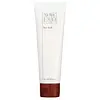What's inside
What's inside
 Key Ingredients
Key Ingredients

 Benefits
Benefits

 Concerns
Concerns

No concerns
 Ingredients Side-by-side
Ingredients Side-by-side

Glycerin
HumectantAscorbic Acid
AntioxidantSesamum Indicum Seed Oil
EmollientC12-15 Alkyl Benzoate
AntimicrobialSodium Cocoyl Isethionate
CleansingHelianthus Annuus Seed Oil
EmollientSodium C14-16 Olefin Sulfonate
CleansingVitis Vinifera Seed Extract
AntimicrobialGinkgo Biloba Leaf Extract
Skin ConditioningPanax Ginseng Root Extract
EmollientStearyl Glycyrrhetinate
Skin ConditioningPhosphatidylcholine
EmulsifyingButylene Glycol
HumectantCarbomer
Emulsion StabilisingSilica
AbrasiveSodium Xylenesulfonate
Sodium Sulfate
Parfum
MaskingTitanium Dioxide
Cosmetic ColorantGlycerin, Ascorbic Acid, Sesamum Indicum Seed Oil, C12-15 Alkyl Benzoate, Sodium Cocoyl Isethionate, Helianthus Annuus Seed Oil, Sodium C14-16 Olefin Sulfonate, Vitis Vinifera Seed Extract, Ginkgo Biloba Leaf Extract, Panax Ginseng Root Extract, Stearyl Glycyrrhetinate, Phosphatidylcholine, Butylene Glycol, Carbomer, Silica, Sodium Xylenesulfonate, Sodium Sulfate, Parfum, Titanium Dioxide
Water
Skin ConditioningCoco-Betaine
CleansingSodium Cocoyl Alaninate
Potassium Cocoyl Glycinate
Acrylates Copolymer
Glycerin
Humectant1,2-Hexanediol
Skin ConditioningPropanediol
SolventPolyglyceryl-4 Caprate
EmulsifyingCaprylyl Glycol
EmollientHydroxyacetophenone
AntioxidantTromethamine
BufferingGlyceryl Glucoside
HumectantDisodium EDTA
Hydrolyzed Hyaluronic Acid
HumectantSqualane
EmollientEctoin
Skin ConditioningCitric Acid
BufferingHydrolyzed Vegetable Protein
Skin ConditioningMaltodextrin
AbsorbentHydrogenated Lecithin
EmulsifyingCeramide NP
Skin ConditioningButylene Glycol
HumectantHyaluronic Acid
HumectantHydrolyzed Sodium Hyaluronate
Skin ConditioningSodium Hyaluronate
HumectantPotassium Hyaluronate
Skin ConditioningHydroxypropyltrimonium Hyaluronate
Sodium Hyaluronate Crosspolymer
HumectantSodium Acetylated Hyaluronate
HumectantWater, Coco-Betaine, Sodium Cocoyl Alaninate, Potassium Cocoyl Glycinate, Acrylates Copolymer, Glycerin, 1,2-Hexanediol, Propanediol, Polyglyceryl-4 Caprate, Caprylyl Glycol, Hydroxyacetophenone, Tromethamine, Glyceryl Glucoside, Disodium EDTA, Hydrolyzed Hyaluronic Acid, Squalane, Ectoin, Citric Acid, Hydrolyzed Vegetable Protein, Maltodextrin, Hydrogenated Lecithin, Ceramide NP, Butylene Glycol, Hyaluronic Acid, Hydrolyzed Sodium Hyaluronate, Sodium Hyaluronate, Potassium Hyaluronate, Hydroxypropyltrimonium Hyaluronate, Sodium Hyaluronate Crosspolymer, Sodium Acetylated Hyaluronate
 Reviews
Reviews

Ingredients Explained
These ingredients are found in both products.
Ingredients higher up in an ingredient list are typically present in a larger amount.
Butylene Glycol (or BG) is used within cosmetic products for a few different reasons:
Overall, Butylene Glycol is a safe and well-rounded ingredient that works well with other ingredients.
Though this ingredient works well with most skin types, some people with sensitive skin may experience a reaction such as allergic rashes, closed comedones, or itchiness.
Learn more about Butylene GlycolGlycerin is already naturally found in your skin. It helps moisturize and protect your skin.
A study from 2016 found glycerin to be more effective as a humectant than AHAs and hyaluronic acid.
As a humectant, it helps the skin stay hydrated by pulling moisture to your skin. The low molecular weight of glycerin allows it to pull moisture into the deeper layers of your skin.
Hydrated skin improves your skin barrier; Your skin barrier helps protect against irritants and bacteria.
Glycerin has also been found to have antimicrobial and antiviral properties. Due to these properties, glycerin is often used in wound and burn treatments.
In cosmetics, glycerin is usually derived from plants such as soybean or palm. However, it can also be sourced from animals, such as tallow or animal fat.
This ingredient is organic, colorless, odorless, and non-toxic.
Glycerin is the name for this ingredient in American English. British English uses Glycerol/Glycerine.
Learn more about Glycerin